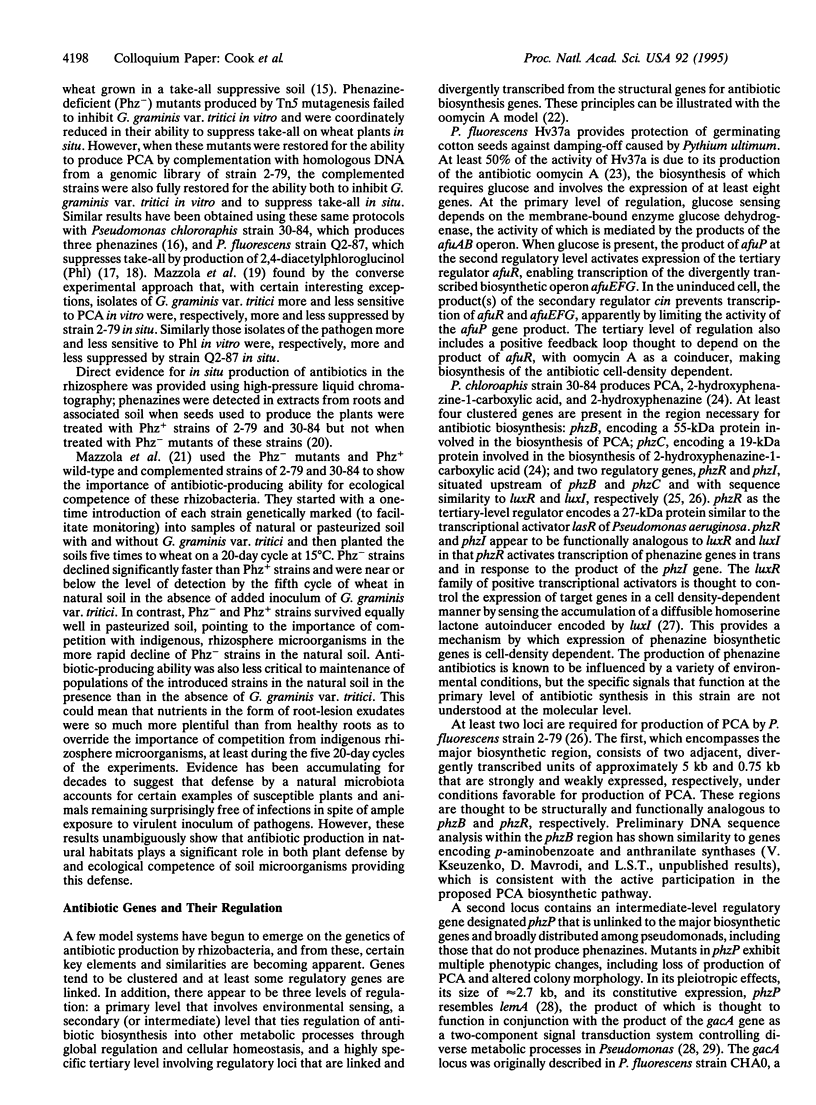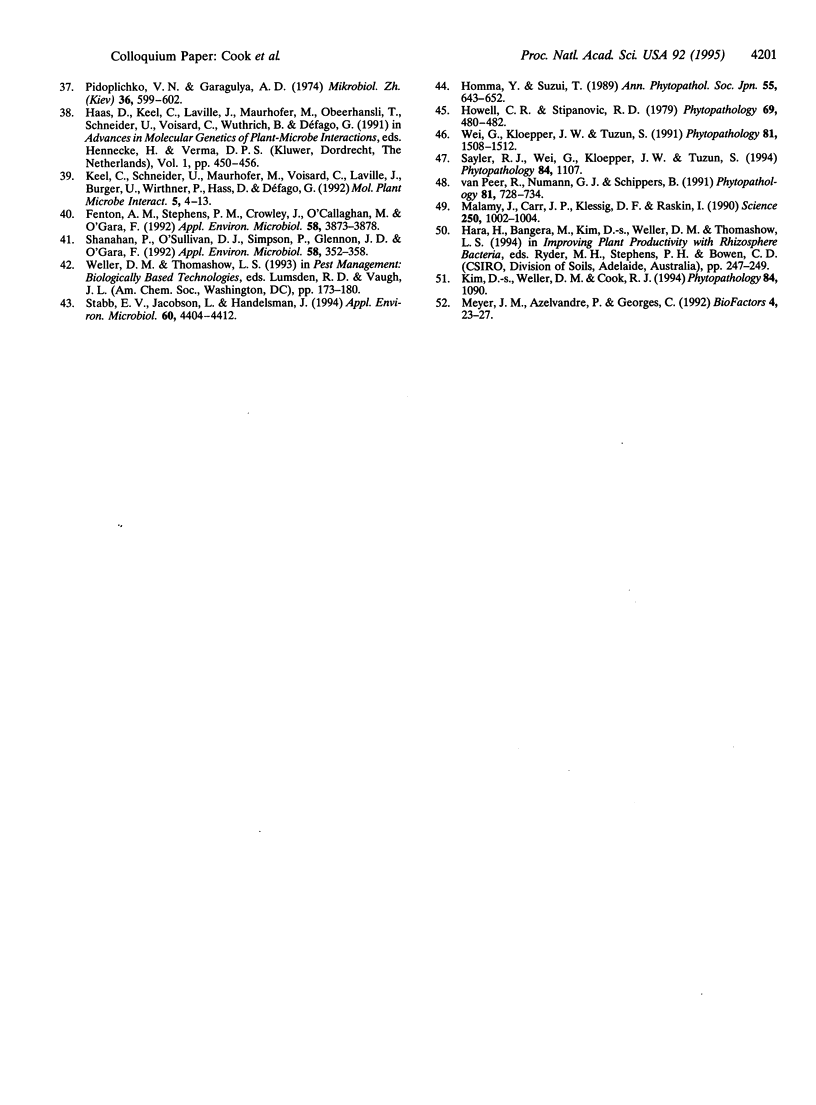Abstract
Genetic resistance in plants to root diseases is rare, and agriculture depends instead on practices such as crop rotation and soil fumigation to control these diseases. "Induced suppression" is a natural phenomenon whereby a soil due to microbiological changes converts from conducive to suppressive to a soilborne pathogen during prolonged monoculture of the susceptible host. Our studies have focused on the wheat root disease "take-all," caused by the fungus Gaeumannomyces graminis var. tritici, and the role of bacteria in the wheat rhizosphere (rhizobacteria) in a well-documented induced suppression (take-all decline) that occurs in response to the disease and continued monoculture of wheat. The results summarized herein show that antibiotic production plays a significant role in both plant defense by and ecological competence of rhizobacteria. Production of phenazine and phloroglucinol antibiotics, as examples, account for most of the natural defense provided by fluorescent Pseudomonas strains isolated from among the diversity of rhizobacteria associated with take-all decline. There appear to be at least three levels of regulation of genes for antibiotic biosynthesis: environmental sensing, global regulation that ties antibiotic production to cellular metabolism, and regulatory loci linked to genes for pathway enzymes. Plant defense by rhizobacteria producing antibiotics on roots and as cohabitants with pathogens in infected tissues is analogous to defense by the plant's production of phytoalexins, even to the extent that an enzyme of the same chalcone/stilbene synthase family used to produce phytoalexins is used to produce 2,4-diacetylphloroglucinol. The defense strategy favored by selection pressure imposed on plants by soilborne pathogens may well be the ability of plants to support and respond to rhizosphere microorganisms antagonistic to these pathogens.
Full text
PDF




Selected References
These references are in PubMed. This may not be the complete list of references from this article.
- Fenton A. M., Stephens P. M., Crowley J., O'Callaghan M., O'Gara F. Exploitation of gene(s) involved in 2,4-diacetylphloroglucinol biosynthesis to confer a new biocontrol capability to a Pseudomonas strain. Appl Environ Microbiol. 1992 Dec;58(12):3873–3878. doi: 10.1128/aem.58.12.3873-3878.1992. [DOI] [PMC free article] [PubMed] [Google Scholar]
- Gaffney T. D., Lam S. T., Ligon J., Gates K., Frazelle A., Di Maio J., Hill S., Goodwin S., Torkewitz N., Allshouse A. M. Global regulation of expression of antifungal factors by a Pseudomonas fluorescens biological control strain. Mol Plant Microbe Interact. 1994 Jul-Aug;7(4):455–463. doi: 10.1094/mpmi-7-0455. [DOI] [PubMed] [Google Scholar]
- Garagulia A. D., Kiprianova E. A., Boiko O. I. Antybiotychna diia bakterii rodu Pseudomonas na fitopatohenni hryby. Mikrobiol Zh. 1974 Feb-Mar;36(2):197–202. [PubMed] [Google Scholar]
- Hamdan H., Weller D. M., Thomashow L. S. Relative importance of fluorescent siderophores and other factors in biological control of Gaeumannomyces graminis var. tritici by Pseudomonas fluorescens 2-79 and M4-80R. Appl Environ Microbiol. 1991 Nov;57(11):3270–3277. doi: 10.1128/aem.57.11.3270-3277.1991. [DOI] [PMC free article] [PubMed] [Google Scholar]
- Laville J., Voisard C., Keel C., Maurhofer M., Défago G., Haas D. Global control in Pseudomonas fluorescens mediating antibiotic synthesis and suppression of black root rot of tobacco. Proc Natl Acad Sci U S A. 1992 Mar 1;89(5):1562–1566. doi: 10.1073/pnas.89.5.1562. [DOI] [PMC free article] [PubMed] [Google Scholar]
- Malamy J., Carr J. P., Klessig D. F., Raskin I. Salicylic Acid: a likely endogenous signal in the resistance response of tobacco to viral infection. Science. 1990 Nov 16;250(4983):1002–1004. doi: 10.1126/science.250.4983.1002. [DOI] [PubMed] [Google Scholar]
- Mazzola M., Cook R. J., Thomashow L. S., Weller D. M., Pierson L. S., 3rd Contribution of phenazine antibiotic biosynthesis to the ecological competence of fluorescent pseudomonads in soil habitats. Appl Environ Microbiol. 1992 Aug;58(8):2616–2624. doi: 10.1128/aem.58.8.2616-2624.1992. [DOI] [PMC free article] [PubMed] [Google Scholar]
- Meyer J. M., Azelvandre P., Georges C. Iron metabolism in Pseudomonas: salicylic acid, a siderophore of Pseudomonas fluorescens CHAO. Biofactors. 1992 Dec;4(1):23–27. [PubMed] [Google Scholar]
- Pidoplichko V. N., Garagulia A. D. Vplyv bakterii-antahonistiv na rozvytok korenevoï hnyli pshenytsi. Mikrobiol Zh. 1974 Sep-Oct;36(5):599–602. [PubMed] [Google Scholar]
- Pierson L. S., 3rd, Thomashow L. S. Cloning and heterologous expression of the phenazine biosynthetic locus from Pseudomonas aureofaciens 30-84. Mol Plant Microbe Interact. 1992 Jul-Aug;5(4):330–339. doi: 10.1094/mpmi-5-330. [DOI] [PubMed] [Google Scholar]
- Sacherer P., Défago G., Haas D. Extracellular protease and phospholipase C are controlled by the global regulatory gene gacA in the biocontrol strain Pseudomonas fluorescens CHA0. FEMS Microbiol Lett. 1994 Feb 15;116(2):155–160. doi: 10.1111/j.1574-6968.1994.tb06694.x. [DOI] [PubMed] [Google Scholar]
- Shanahan P., O'sullivan D. J., Simpson P., Glennon J. D., O'gara F. Isolation of 2,4-diacetylphloroglucinol from a fluorescent pseudomonad and investigation of physiological parameters influencing its production. Appl Environ Microbiol. 1992 Jan;58(1):353–358. doi: 10.1128/aem.58.1.353-358.1992. [DOI] [PMC free article] [PubMed] [Google Scholar]
- Stabb E. V., Jacobson L. M., Handelsman J. Zwittermicin A-producing strains of Bacillus cereus from diverse soils. Appl Environ Microbiol. 1994 Dec;60(12):4404–4412. doi: 10.1128/aem.60.12.4404-4412.1994. [DOI] [PMC free article] [PubMed] [Google Scholar]
- Thomashow L. S., Weller D. M., Bonsall R. F., Pierson L. S. Production of the antibiotic phenazine-1-carboxylic Acid by fluorescent pseudomonas species in the rhizosphere of wheat. Appl Environ Microbiol. 1990 Apr;56(4):908–912. doi: 10.1128/aem.56.4.908-912.1990. [DOI] [PMC free article] [PubMed] [Google Scholar]
- Thomashow L. S., Weller D. M. Role of a phenazine antibiotic from Pseudomonas fluorescens in biological control of Gaeumannomyces graminis var. tritici. J Bacteriol. 1988 Aug;170(8):3499–3508. doi: 10.1128/jb.170.8.3499-3508.1988. [DOI] [PMC free article] [PubMed] [Google Scholar]
- Vincent M. N., Harrison L. A., Brackin J. M., Kovacevich P. A., Mukerji P., Weller D. M., Pierson E. A. Genetic analysis of the antifungal activity of a soilborne Pseudomonas aureofaciens strain. Appl Environ Microbiol. 1991 Oct;57(10):2928–2934. doi: 10.1128/aem.57.10.2928-2934.1991. [DOI] [PMC free article] [PubMed] [Google Scholar]


